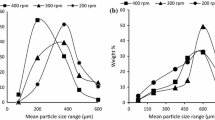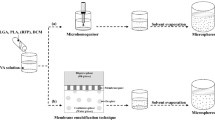Abstract
The purpose of this research was to investigate the effects of different concentrations of polymer and sucrose stearate, aluminum tristearate as dispersing agents on microsphere properties and performance. The yield values of microspheres were over the 78%, and the encapsulation efficiencies were found to be ∼735. Particle sizes of microspheres prepared with aluminum tristearate were between 76 and 448 μm, while that of the microspheres containing sucrose stearate were between 521 and 2000 μm. Morphological and physicochemical properties of microspheres were investigated by scanning electron micrography and differential scanning calorimetry (DSC). DSC analysis indicated that verapamil hydrochloride formed a solid solution with acrylic polymers. In vitro release studies were performed using the flow-through cell method. While ∼80% of drug was released from the microspheres containing aluminum tristearate in 480 minutes, the same amount of drug was released from microspheres containing sucrose stearate in only 60 minutes. Chemical structures and concentrations of the dispersing agents were clearly effective on the physical properties of microspheres and their drug-release characteristics.
Similar content being viewed by others
References
Passerini N, Perissuti B, Albertini B, Voinovich D, Moneghini M, Rodriguez L. Controlled release of verapamil hydrochloride from waxy microparticles prepared by spray congealing. J Control Release. 2003;88:263–275.
Soppirnath KS, Aminabhavi TM. Water transport and drug release study from cross-linked polyacrylamide grafted guar gum hydrogel microspheres for the controlled release application. Eur J Pharm Biopharm. 2002;53:87–98.
Jalil R, Nixon JR. Microencapsulation using poly(L-lactic acid). II. Preparative variables affecting microcapsule properties. J Microencapsul. 1990;7:25–39.
Yüksel N, Tükoglu M, Baykara T. Modelling of the solvent evaporation method for the preparation of controlled release acrylic microspheres using neural networks. J Microencapsul. 2000;17:541–551.
Bezemer JM, Radersma R, Grijpma DW, Dijkstra, PJ, Blitterswijk CA, Feijen J. Microspheres for protein delivery prepared from amphiphilic multiblock copolymers. 1. Influence of preparation techniques on particle characteristics and protein delivery. J Control Release. 2000;67:233–248.
Blanco-Prieto MJ, Leo E, Delie F, Gulik A, Couvreur P, Fattal E. Study of the influence of several stabilizing agents on the entrapment and in vitro release of pBC 264 from poly(lactide-co-glycolide) mcirospheres prepared by a w/o/w solvent evaporation method. Pharm Res. 1996;13:1127–1129.
Blanco D, Alonso MJ. Protein encapsulation and release from poly (lactide-co-glycolide) microspheres: effect of the protein and polymer properties and of the co-encapsulation of surfactants. Eur J Pharm Biopharm. 1998;45:285–294.
Lambert O, Nagele O, Loux V, Bonny JD, Marchal-Heussler L. Poly(ethylene carbonate) microspheres: manufacturing process and internal structure characterization. J Control Release. 2000;67:89–99.
Arshady R. Microspheres and microcapsules, a survey of manufacturing techniques. Part III: solvent evaporation. Polym Eng Sci. 1990;30:915–924.
Tcancov St, Lambov N, Minkov E. Preparation of tinidazol microspheres using polyacrylate resins. Pharm Ind. 1991;53:695–698.
Pradhan RS, Vasavada RC. Formulation and in vitro release study on poly (DL-lactide) microspheres containing hydrophilic compounds: glycine homopeptides. J Control Release. 1994;30:143–154.
Diaz RV, Soriano I, Delgado A, Llabres M, Evora C. Effect of surfactant agents on the release of 125I-bovine calcitionon from PLGA microspheres: in vitro—in vivo study. J Control Release. 1997;43:59–64.
Yüksel N, Baykara T. Preparation of polymeric microspheres by the solvent evaporation method using sucrose stearate as a droplet stabilizer. J. Microencapsul. 1997;14:725–733.
Bhardwaj SB, Shukla AJ, Collins CC. Effect of varying drug loading on particle size distribution and drug release kinetics of verapamil hydrochloride microspheres prepared with cellulose esters. J Microencapsul. 1995;12:71–81.
Soppimath KS, Kulkarni AR, Aminabhavi TM. Encapsulation of antihypertensive drugs in cellulose matrix microspheres: characterization and release of microspheres and tableted microspheres. J Microencapsul. 2001;18:397–409.
Kiliçarslan M, Baykara T. Effects of the permeability characteristics of different polymethacrylates on the pharmaceutical characteristics of verapamil hydrochloride-loaded microspheres. J Microencapsul. 2004;21:175–189.
Jenquin M, Liebowitz S, Sarabia R, McGinity J. Physical and chemical factors influencing the release of drugs from acrylic resin films. J Pharm Sci. 1990;79:811–816.
Gao ZG, Oh KH, Kim C-K. Preparation and characterization of sustained-release microspheres of chlorpromazine. J Microencapsul. 1998;15:75–83.
Kiliçarslan M, Baykara T. The effect of the drug/polymer ratio on the properties of the verapamil HCl loaded microspheres. Int J Pharm. 2003;252:99–109.
Horoz BB, Kiliçarslan M, Yüksel N, Baykara T. Effect of different dispersing agents on the characteristics of Eudragit microspheres prepared by solvent evaporation method. J Microencapsul. 2004;21:191–202.
Morlock M, Koll H, Winter G, Kissel T. Microencapsulation of rh-erythropoietin, using biodegradable poly(D,L-lactide-co-glycolide): protein stability and the effects of stabilizing excipients. Eur J Pharm Biopharm. 1997;43:29–36.
Kawata M, Nakamuro M, Goto S, Aoyama T. Preparation and dissolution pattern of Eudragit RS microcapsules containing ketoprofen. Chem Pharm Bull (Tokyo). 1986;34: 2618–2623.
Mateovic T, Kriznar B, Bogataj M, Mrhar A. The influence of stirring rate on biopharmaceutical properties of Eudragit RS microspheres. J Microencapsul. 2002;19:29–36.
Yüksel N, Baykara T. Interaction between nicardipine hydrochloride and polymeric microspheres for a controlled release system. Int J Pharm. 1996;140:145–154.
Ntawukuliyayo JD, Bouckaert S, Remon JP. Enhancement of dissolution rate of nifedipine using sucrose ester coprecipitates. Int J Pharm. 1993;93:209–214.
Author information
Authors and Affiliations
Corresponding author
Additional information
Published: February 24, 2006
Rights and permissions
About this article
Cite this article
Horoz, B.B., Kiliçarslan, M., Yüksel, N. et al. Influence of aluminum tristearate and sucrose stearate as the dispersing agents on physical properties and release characteristics of Eudragit RS microspheres. AAPS PharmSciTech 7, 16 (2006). https://doi.org/10.1208/pt070116
Received:
Accepted:
Published:
DOI: https://doi.org/10.1208/pt070116




